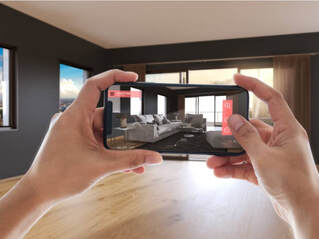 Augmented Reality, without a doubt, is the technology of the future. While the first picture that comes to mind when talking about AR is that of games and entertainment, today, various segments of the world are using AR for several purposes. AR in Education Sector Augmented reality in educational institutions is growing at a rate of 17.9% annually. This steady domination will lead to AR becoming a major part of classroom education. One of the best things about AR is that most AR applications run on smartphones or tablets needing no special equipment. This makes augmented reality technology especially adaptable for use in the education industry. Using concepts of Augmented Reality, with its fun elements, graphics, infographics, will not only help students focus more, it will also lead to higher participation. AR-enabled learning can be used by providing 3D examples of concepts which will allow students to learn better. AR in Construction and Architecture Augmented Reality applications can provide a more accurate view of what will be built, including all layers of materials and installations that are often complex to understand through drawings. For this, 3D plans and even virtual model holograms are used to improve the understanding of the project and facilitate the execution of projects. And even during construction, the ability to see through walls and understand the path of the technical installations facilitates the process, reduces the possibility of errors, and even guides the construction of complex geometries. Augmented reality has a wealth of design and construction uses beyond visualization too. It can be used for design analysis to pick out clashes by virtually walking through your completed model. It fits the bill for constructability review by letting the architect and contractor collaborate on changes that have to happen between design and construction due to constructability issues. It can even assist with prefabrication of building components. AR in the Health Industry Today, surgeons use several techniques to visualize the area on which they are to operate, but augmented reality, which can project three dimensional representations of the patient’s anatomy into the surgeon’s field of view, is likely to improve accuracy and outcomes for patients. Augmented reality opens new doors for surgery by improving education for young doctors and providing surgeons with a more functional platform to zero in on their micro-movements. AR applications allow medical professionals to recreate images of anatomical structures virtually, an image they can then project onto the surgical site in real-time. Essentially this is a form of data visualization. A high-resolution projection of patient vitals and other relevant information that the surgeon would normally have to divert attention to obtain. AR in tourism Another area where this innovative technology is being used is travel. Making the tourist experiences even more special, AR technology is being widely embraced in many countries. Thanks to this technology, tourists now have access to tourist information and guides not only in the written version but also in the form of audio, making it even easier to explore tourist spots. Another special feature is the 360-degree tours that are easily accessible, thus making it possible to virtually explore a place before visiting reality. This technology is not only used by travel agencies but also by restaurants and hotels that offer virtual tours of their facilities, giving guests a virtual experience of what to expect. AR in Military The first and foremost example of using AR in the defence sector was in training soldiers. Augmented reality enabled devices like a head-mounted display can overlay blueprints or a view from a satellite or overheard drone directly onto the soldiers' field of vision. Defence manufacturers are already supplying such headsets to armies all over the world - from the U.S.A to India. An AR system Synthetic Training Environment also helps train soldiers in a more immersive way, putting them into more physically and mentally stressing operational environments. AR in Journalism AR media will definitely create whole new interactive formats and opportunities to increase revenue per customer in the media industry. In the news and journalism space, the use of VR and AR in media has the potential to bring readers and viewers deeper into a story than text, standard images and even standard video ever could. Promising recent examples of VR media include the UN's 360-degree report from inside a refugee camp in 2015 which is a first-of-its-kind, immersive experience that brings the watcher into the story. It is crystal clear that Augmented Reality has an immense scope for usage in every single industry. There have been great strides in AR technology in the past and there is a lot more to come. Comments are closed.
|
AuthorVisioWorx Pvt Ltd is a multifaceted established company dealing in specialized solutions. Archives
October 2021
Categories |
|
|
VisioWorx Pvt Ltd 2021
 RSS Feed
RSS Feed


